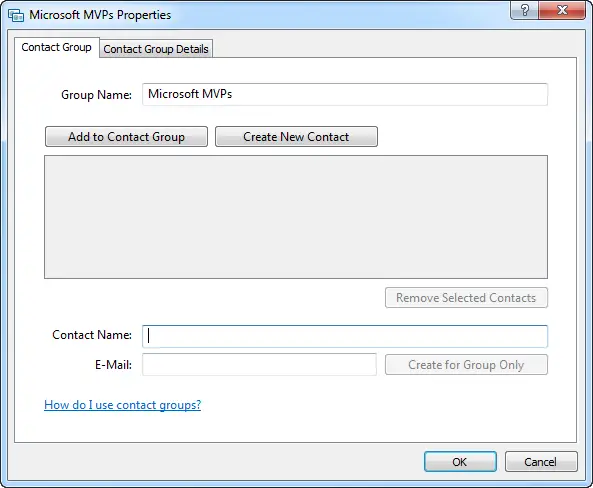Managing hundreds or thousands of Contact details in a uniform way is such a time-consuming affair, but with Windows 7, it is not so anymore! Many of us know about Contacts on our Windows PC, but most of us don’t use it to keep records of our contacts using the available Contacts folder.Contact details in a uniform way are such a time-consuming affair, but with Windows, it is not so anymore! Many of us know about Contacts on our Windows PC, but most of us don’t use it to keep records of our contacts using the available Contacts folder.
Manage Contacts & Addresses in Windows PC
Windows has a very nice and easy-to-manage Contacts system by default in it. You can use it to keep track of people and organizations by creating contacts for them in Windows Contacts. Each contact contains information about one person or organization.
When you need to look up a friend’s email address or phone number, you can find it in the Contacts folder. When you want to keep notes about a business contact, you can store them in the Contacts folder. You can also store pictures of contacts in the Contacts folder.
A Contact file contains:
- Email addresses: Store as many email addresses as you want for a contact, and set one as the preferred address.
- A picture: Adding a picture of contact can help you remember the person.
- Phone numbers: You can store home, work, mobile, and fax phone numbers for a contact.
- Street addresses: You can store home and work street addresses for a contact.
- Family information: You can store information about a contact’s spouse or partner, children, gender, birthday, and anniversary.
- Website addresses: You can store home and work website addresses for a contact.
- Notes: Use this space to add any other information about a contact.
Adding a New Contact.
- Click on Start and then search for Contacts and open Contacts folder (the folder is located in user’s folder).
- Click New Contact, type the information you want for the contact in any of the boxes on the available tabs, and then click OK. You don’t have to fill in all the boxes; just enter as much information as you want.
Note: If you add an email address to the new contact, click Add before clicking OK.
Adding information to an existing contact.
- Click on Start and then search for Contacts and open Contacts folder (the folder is located in the user’s folder).
- Double-click the contact you want to change.
- Click the tab where you want to add information, type in any of the available boxes, and then click OK.
Adding or changing a contact’s picture
Windows adds a default image for each contact, but you can change that image to a photo or other picture.
- Click on Start and then search for Contacts and open Contacts folder (the folder is located in the user’s folder).
- Double-click the contact whose picture you want to change.
- On the Name and email tab, click the contact picture, and then do one of the following:
- To add a new picture, click the picture and then click Change picture. Browse the picture you want to use, click it, click Set and then click OK.
- To remove an existing picture, click the picture, click Remove Picture, and then click OK. The picture will revert to the default contact image used by Windows. (You can’t remove the default image.)
Creating contact groups (mailing lists).
You can also create contact groups, which combine multiple individual contacts into a single group with one email address. If you send an email message to a contact group, it’s sent to everyone in the group. Sending an email to a contact group can be a lot easier than adding names one at a time to an email message, especially if you often send messages to the same group of people.
Sending contacts to other people.
Besides storing contact information about people and organizations, you can also send contacts to other people. There’s no need to type a bunch of phone numbers, addresses, and other contact information into an email message—just send them a contact with the information you want to share. The most common way to send a contact is to attach it to an email message. (The steps to attach a file vary depending on what email program you use. for e.g. Windows Live Mail, Office Outlook, Thunderbird, etc.)
Note: To send a contact to someone who’s not using Windows, you might first need to export the contact to another format.


I have exported the 835 contacts from my iPhone to a .vcf file. When I open this file using Windows Contacts, I see each contact displayed (in some random order), with the option of “Add to my contacts”. If I “X” out of a contact, or click “Cancel”, the next contact in the file is displayed. There seems to be no way to shut this down, short of shutting down the computer. When I do restart the computer, it is in fact stopped, but how do I stop it without shutting down the computer? Compounding this issue is the fact that each contact is displayed in a slightly different position on the screen, so I can’t just hold the cursor in the spot where the “X” appears and click away. In Task Manager, each contact appears as a Task under Applications, and if I End that task, the next one appears. The mother process appears to be wab.exe, and ending that does in fact end the endless march of vCards, but is this a safe way to end it?
All I want to know, and no one seems to answer to the “Point”. Is why do I have 2 or 3 duplicates in my Contacts? And how to Delete duplicates in mass. Not one at the time.
Your cohirent input much apreciated.
m.k.